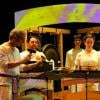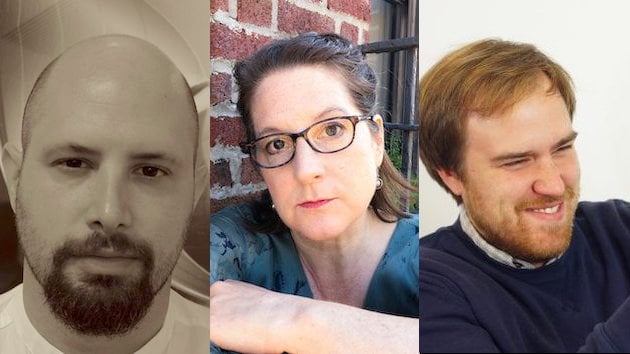
-
A few tense weeks after shelter-in-place orders had been issued, composer Brian Baumbusch found himself one April morning in the produce section of a Safeway supermarket near his East Bay home. Tricked-out in royal-blue disposable gloves, a bright white N95 mask covering most of his trimmed dark beard, and headphones clamped over his ears, Baumbusch cautiously navigated his grocery cart past other shoppers, many garbed in similar PPE. He was listening for the first time to his rough mix of the second movement of his new work for winds, which includes breathing sounds.
As Baumbusch tells it, it was at a very specific point in the movement, when the breath sounds are exposed, that the supermarket’s ambient noise became suddenly inaudible and he stood still: All he could hear were the recorded air sounds through his headphones and his own intense breathing under the mask. When he looked around the brightly lit grocery aisle, he saw a socially distanced archipelago of masked faces cautiously staring back: He could feel the charged currents of shared concern zig-zagging among them. “We were all worried we might be getting each other sick,” Baumbusch told me in a phone call in early October, recalling a pivotal moment in creating his new 25-minute work Isotropes.
While fear of contagion grew around the world, he continued to write, mix and eventually reamplify the four-movement piece in various phases from mid-March through early June, a timeframe which included daily media reports of COVID-19 body counts, the Black Lives Matter movement, a divisive presidential campaign, and the devastating infernos of West Coast wildfires. The 33-year-old worked from his Alameda Island home, where he has been sheltering-in-place with his wife and their toddler, while 40 musicians recorded the musical fragments remotely.
Right after he finished the third movement, but before starting the fourth, he hit a rough patch in his personal life. Then in late May, half-way through writing the fourth and final movement, George Floyd was killed, the result of suffocation. The events extracted an emotional toll from him. “The breathing aspect of the piece was very hard for me to create,” he told me, “the fourth section — it was everything I could do to be working on it.”
Pandemic Music
Baumbusch is one of many composers creating classical music tied to the pandemic — much of it living online or performed virtually on streaming platforms and apps. Working within the physical constraints that COVID-19 has imposed, these composers are employing a range of compositional approaches and strategies, from advanced technology, collaboration, and ideas of play to community input.
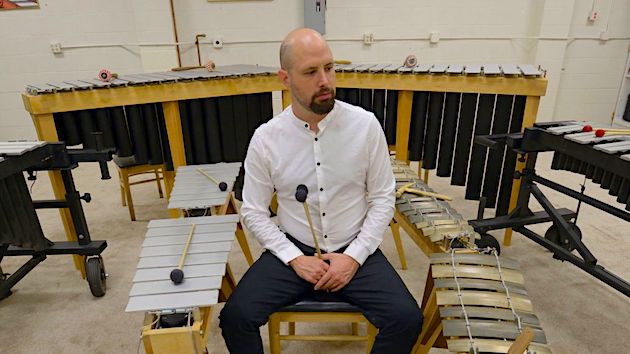
The pieces would seem to fall into a rubric popularly labeled pandemic music. The nomenclature has historic precedent, from works created during the medieval-era plague in Europe and the Spanish flu in the early 20th century to those composed at the height of the AIDS epidemic. But these new creations fit neatly inside the category of crisis and commemorative music, according to Smith College musicologist Andrea Moore, an expert on contemporary American music, particularly commemorative, including 9/11.
“Part of situating pandemic music is finding its alliances with other works created during trying times,” Moore told me in a phone call in late October from her Western Massachusetts home. “There is music written about all kinds of crises. The repertoire of works created during the AIDS crisis, many of which are commemorative, is closest to situate it with.” She noted the overlap of music created while the AIDS epidemic was at its height (1981-1996), and that continues to be composed. “In the pandemic, as well as the AIDS crisis,” she said, “things are being documented as they happen.”
Whether the different approaches composers are using in their pandemic works will enrich or influence classical music composition in years after COVID-19 remains to be seen. Some of the pieces reveal themselves to be an artistic reaction to the pandemic and other dramatic events thus far of 2020. Other pieces, observers note, might be a reflection on the pandemic, or offer sonic resources for coping strategies. Most of them aren’t being widely heard — without sticky engagement strategies to drive audiences to the works, combined with the very deep well of online artistic creation during the coronavirus so far, it seems somewhat of a crapshoot which ones will have an extended shelf-life.
Often the artistic viability of music created during trying times turns on whether there’s an anniversary calendar that pieces can attach themselves to down the line, said Moore. “The odds of them becoming repertorial are no greater or worse than any piece of new music,” she said. Many 9/11 commemorative pieces haven’t been played again, she noted, mostly referring to 10th anniversary commissions.
Remote Collaboration
Isotropes, which the University of California, Santa Cruz Wind Ensemble commissioned in March, has already beaten those odds. The Cal State University, Fullerton Wind Symphony picked up the piece and plans to complete its recording by June 2021, said Baumbusch, who teaches at UC Santa Cruz, where he earned his DMA. He’s had additional interest, and the opportunity to create Isotropes, he told me, has increased his professional outreach as a composer. “For me it was a golden goose egg to do something new,” he said.

Unlike many classical music pieces created thus far during the pandemic that have been performed live virtually on a streaming platform or app, where musicians each play their instrument remotely but in unison with each other, Baumbusch hung a big left with his new work.
He’d already been experimenting with polytempic music — favored by such 20th-century composers as Conlon Nancarrow, Karlheinz Stockhausen, Frank Zappa. And he’d first used click-tracks (which keeps a musician’s recording precisely in tempo, as a metronome would) on a commission from the JACK Quartet, and with his own Lightbulb Ensemble in 2015.
“What makes Isotropes unique is that it’s designed for a remote collaboration model,” he told me. “It’s not the asynchronous Zoom concept — it is hyper-synchronous, a novel explosion of musical time. It’s not that it never has happened before. But it was a fringe element. Up until now, 95 to 99 percent of all music made had a common sense of what musical time is,” said Baumbusch, whose sound world include classical Spanish guitar (which he studied as a teenager in Spain — you can hear a nod to Miles Davis’ Sketches of Spain in the opening minutes of Isotropes); Balinese gamelan; Lou Harrison; and the minimalism of Kyle Gann, with whom he studied at Bard.
The work would be more difficult for musicians to perform together in a concert hall than in its current incarnation. “It’s not that I set out to do something that would be hard to perform live,” Baumbusch explained. A student musician who played in Isotropes noted that the work couldn’t have been made even a year ago. Baumbusch disagreed. “It’s not that it’s 2020 music because the technology wasn’t there in 2019,” he told me. “It’s 2020 music if only because no group would have agreed to do it then. It was a solution to a problem.”
The use of technology by Baumbusch and other composers to make works during the pandemic may end up enriching and influencing composition in the post-pandemic years, Moore told me. “Documentation has been done; what is new are the technical explorations — the ability to make music at a great distance without having to be in the same room,” she said.
Making music from afar is the direction Manhattan-based composer and vocalist Lisa Bielawa took when New York City went into lockdown on March 22. Suddenly Bielawa, a longtime vocalist with the Philip Glass Ensemble, found herself with lucrative tours cancelled, various scheduled projects postponed, and her own life radically altered. She was quickly able to find funding to help support Broadcast from Home, her 15-chapter work that features more than 500 submitted testimonies and recorded voices about life during the pandemic from six continents, she said.
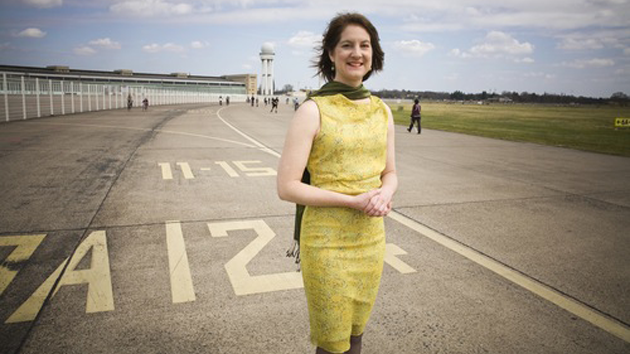
The work came out of exigencies, she told me in a phone call in early October from her Upper West Side apartment. There was no score, said the 52-year-old, noting the pandemic turned her compositional method completely on its head. “It was terrifying, it was raw and it also has brought me into a much more intuitive process,” said Bielawa, who grew up in a musical family but is not conservatory trained — she studied literature at Yale. “I hope that stays with me and informs my work in the future.”
No stranger to creating large-scale remote music projects, she put together a hectic weekly production cycle that began on a Wednesday. Rising at 4:30 a.m., Bielawa would write in her diary and by 6:30 a.m., still in pajamas, she’d be on her living room couch, more coffee at the ready, sharpened pencil in hand as she read through printed copies of that week’s submitted testimonials (cued from a collaborator’s weekly written prompt). She selected verbiage from testimonials that seemed to take the pulse of the moment, and then moved to the piano to set them to music. (Some of the chapters also use field audio.) The cycle continued with recordings and uploads until it was Wednesday morning — again.
Her virtual solitude during the pandemic’s first long wave in New York was difficult. “I love living alone but suddenly,” she told me, “I was in extreme isolation. I didn’t have a hug for five months. For a touch-starved person, it was like being touched by these voices. I don’t know how I would have gotten through it; it was really painful by the end.”
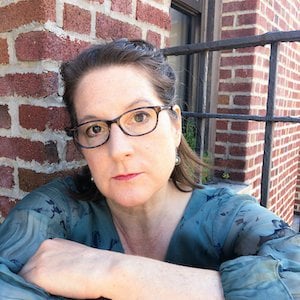
Evenings were often punctuated by joining others in her neighborhood for a 7 p.m. bang-on-a-pot ritual in front of her bedroom window to salute health-care workers at the Columbia-Presbyterian Medical Center, a block away. Save for market visits and daily runs that frequently took her past refrigerated trucks of bodies parked by the hospital overwhelmed with COVID-19 cases, she pulled longs hours working on the piece.
As of July 16, she placed the project on hiatus partly, she said, because the testimonials’ emotional tenor had changed as parts of the country were opening up, and partly to focus on her Voters’ Broadcast before the November election. Both projects, she said, are about people participating in a crisis that pulls them together. “That’s what people were doing with me,” she told me, “they literally want to be part of a fabric of something. The pandemic is not over. People are still dying ... we can’t give up on this time because it’s hard to make music.”
Sonic Meditation for an Anxious Time
Meanwhile, back on the other side of the country during the early part of the pandemic, San Francisco composer Danny Clay was taking a very different tack with his work Music for Hard Times. Two days before San Francisco’s official shelter-in-place orders on March 16, Clay and his musical collaborators, the Bay Area guitar and percussion performance duo The Living Earth Show (Travis Andrews and Andy Meyerson), who commissioned the work, gave themselves the creative brief: “Is it possible to use the tools of classical art music to make people feel better?”

Instead of a traditional score, Clay, a conservatory-trained composer, sent the duo a series of calming strategies in a format somewhat in the tradition of Pauline Oliveros-style sonic meditations. They were usually one page, with hand-drawn, text-based prompts such as “take a deep breath and make a sound on the out breath.” Or “go outside and make a sound.”
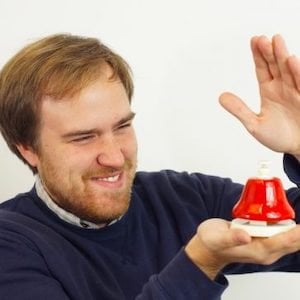
The duo sent Clay back hundreds of these composed exercises (that used nearly a dozen of his calming strategies), which each had separately recorded remotely using voice, field recordings, found objects and instruments. Clay took the recordings, without any idea of how they’d fit together, and created an eight-movement sonic collage — “they were like puzzle pieces” — that became Music for Hard Times, he told me in a phone call in early October.
“Shelter-in-place placed a new kind of imperative on the creative constraints of working apart but this was not a new process for me,” he told me. He composed the piece from the Diamond Heights home he shares with his wife. He worked from their small deck overlooking San Francisco’s Twin Peaks, wrapped in a sweater against a fickle wind, headphones on, leaning over his laptop resting on a beige TV tray until fading daylight and the glow of nearby apartment lights sent him inside the couple’s bedroom to work a few more hours. “San Francisco has this rare gift of urban beauty and natural space, which I always find to be a poignant combination,” Clay emailed me to say in later October, “and it offered a visual counterpoint to the music I was working on in a way that’s hard to pinpoint.”

He spent most of April and May mixing the work. The trio decided to add images of Northern California taken by photographer Jon Fischer as a visual component. The piece had its world premiere June 26 on a Facebook livestream of “Living Music with Nadia Sirota.” While his personal creative approach, he said, has been possibly less affected by the pandemic than that of other musicians and composers, he was excited to find a new way to collaborate remotely with others. And what started as a labor of love is now is a musical gift, said the 31-year-old Ohio native. The University of Maryland has commissioned the trio to create a new iteration of Music for Hard Times.
I asked how he could be sure of a successful outcome in the new version he was working on, given the I Ching-like approach to how the piece comes together. “My sense is humans are instinctual puzzle solvers,” said Clay, who has spent a decade teaching children music. And in that time, he told me, he’s watched how they figure things out. “Our minds are perfectly equipped to put things together. We want to make sense of things and build meaning into things.”
Reaction and Reflection
I’d listened to each of the three composers’ pandemic works before speaking with them, and after. Baumbusch’s because I wanted to hear the breathing sounds that come in, he told me, at the eight-minute mark in Isotropes. I did yoga while listening to Clay’s Music for Hard Times and felt a deeper calm for it. When I heard again several chapters of Bielawa’s Broadcast from Home, I’d already been inside for several days because of unhealthy air from nearby wildfires. I felt the immediacy of the elegant fragments for voice and piano, with their rollercoaster of emotions including glimmers of hope, depths of despair, but they also felt unsettling layered on top of my confinement from the fires and ongoing uncertainty about the virus. So I pulled on my N95 mask to take my SIP-adopted dog for a late afternoon, contemplative walk in the smoky air.
It was still warm outside, but the Berkeley sidewalks were devoid of people. A salmon-pink colored ice cream truck inched up the block, trolling the leafy street for customers as it boomed a treacly loop of It’s a Small World (after all) through a speaker jerry-rigged to its roof. The truck was a normal trapping of the still summer weather, but no one came out of their homes to answer its siren call. The annoying Disney tune lodged in my brain like an ear worm and when I returned home, I Googled it out of curiosity. I learned it had been written in the wake of the 1962 Cuban missile crisis, which influenced its Cold War lyrics that include such paeans to world peace as “it’s a world of hopes, it’s a world of fears.” I realized the song, conceived in a trying time, would fit into the category of crisis music.
Afterward, I thought about Bielawa’s confinement and uncertainty while living in New York at the height of its lockdown earlier in the spring, especially her jogs past the refrigerated temporary morgue trucks parked not far from her apartment building. The urgency of her project reflected the experience of a composer living through a trying time. Had she waited until after the pandemic was over to create the work from the testimonials gathered during the pandemic, it would have changed the immediacy of the interplay between testimonial and quick creative response time.

There’s no benefit or drawback to letting time elapse, or not, in terms of a work’s critical merits, Moore told me. “It goes back to overlap between reaction and reflection,” she said. The importance of reflection in crisis music, in terms of works produced, she explained, is entirely up to the composer. Some feel the need to wait. Others want something quite different and want to respond now. Some composers have had a close emotional connection to the pandemic works they created, and some have not.
While the pandemic is affecting everyone in different ways, no one is exempt, she noted, adding that is what sets this crisis apart from the AIDS crisis of the years 1981–1996. The year 2020, Moore continued, is about so much more than the pandemic. “Maybe in 10 years the hierarchy of importance will have shifted,” she told me. “That the pandemic is what will recede in terms of collective public memory is unknown.”
Getting the Mix Right
It had been three weeks since the last area evacuation from wildfires when, on an early September morning, Baumbusch pulled his Toyota SUV up to the ash-covered loading dock of the concert hall on the UC Santa Cruz campus, still closed since SIP orders. He was there to reamplify Istotropes and an earlier work, Tides, in the venue, as both are on an EP slated for a mid-December 2020 release.
The air quality was better than the hazardous levels it had been the previous weeks, which had delayed the reamp. Still the air smelled faintly acrid as he stepped outside. There was no one else around but he pulled on disposal gloves and a mask in compliance with university virus safety protocols. Grey-white ash swirled under the wheels of the rented high-end audio equipment he rolled across the dock, revealing a wake of grimy residue underneath like the bottom of a recently emptied full ashtray. He spent most of the long reamplifying session seated in the hall’s back row, middle seat, still wearing PPE despite his solitary presence.
In an email exchange with Baumbusch later in October, I asked whether there was something about his compositional process and final assemblage of Isotropes that suggested mirrors within a mirror because of the various echo memes in creating the piece. He said he could understand the concept but that it never was part of his intent.
“When I listen to that final mix, I’m able to have multiple simultaneous experiences (reflective of the multiple simultaneous tempi in the piece),” he wrote, “because I can place myself back in the hall (and, in essence, transport anyone who listens to the recording to that hall) because I know that what I’m hearing was captured in that moment. But I also know that contained in that mix is the combination of thousands of other private moments and private spaces. This makes that particular recording extremely rich for me, much more so than any of the acoustic real-time recordings that I’ve created under normal pre-COVID-19 circumstances.”
Given that the pandemic, for now, has no end in sight, and the year’s dramatic events continue to unfold, I wondered if Baumbusch had considered a more somber ending to Isotropes than the peaceful cadence that brings “Reconciliation,” the work’s final movement, to a close. “No,” he told me, “I wanted to create something emotionally cathartic but one with an uplifting spirit. It felt like a perfect way to end.”
Correction: The article, as originally published, cited Steve Reich’s WTC 9/11 as an example of a commemorative piece that has not had subsequent performances. It has, in fact, been played since its premiere.



